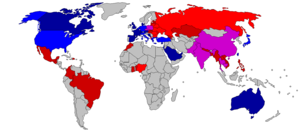
Back الاتجار بالبشر Arabic طرافيك د بنادم ARY İnsan alveri Azerbaijani Гандаль людзьмі BE-X-OLD Трафик на хора Bulgarian ထာꩻစာအမ်ႏလိုꩻ BLK মানব পাচার Bengali/Bangla Trgovanje ljudima BS Tràfic de persones Catalan بازرگانیی مرۆڤ CKB


Human trafficking (or Trafficking in human beings) is a way to exploit people. People are sold, bought, traded much like slaves , and are even sold to couples who don't have children. It is estimated to be a $5 to $9 billion-a-year industry.[1] Trafficking victims typically are recruited by using force or because they are deceived, or fraud is used, power is abused, or they are simply abducted. Threats, violence, and economic problems can often make a victim consent to exploitation.
Human trafficking should not be confused with human smuggling.[2][3][4]
- ↑ "Economic Roots of Trafficking in the UNECE Region".
- ↑ "The difference between human trafficking and smuggling".
- ↑ Quan, Douglas (21 June 2019). "Alleged human-smuggling operation may have brought hundreds of Chinese migrants across B.C. Border". National Post.
- ↑ "Human Trafficking and Migrant Smuggling". Archived from the original on 2018-12-12. Retrieved 2019-06-22.